Strategic Problem Solving and Decision Making in Lloyds Banking
VerifiedAdded on 2023/06/09
|10
|2664
|234
Report
AI Summary
This report examines the problems faced by Lloyds Banking Group, particularly concerning branch closures and the transition to digital banking. It uses SWOT and PESTLE analyses to evaluate internal and external factors impacting the bank. The report highlights the unrest among customers unfamiliar with digital banking, job losses, and the decline in shareholder value. Recommendations to resolve these issues include balancing digital services with maintaining physical branches, offering customer incentives, and engaging with local communities. A decision-making matrix is used to identify the best solution, emphasizing the importance of continuing digitalization while preserving high street banking. The report concludes by discussing the implementation and communication of these decisions, stressing the need for monitoring and feedback to ensure the effectiveness of the proposed solutions. Desklib offers a variety of resources, including similar solved assignments and past papers, to aid students in their studies.

Problem Solving and
Decision Making
Decision Making
Paraphrase This Document
Need a fresh take? Get an instant paraphrase of this document with our AI Paraphraser
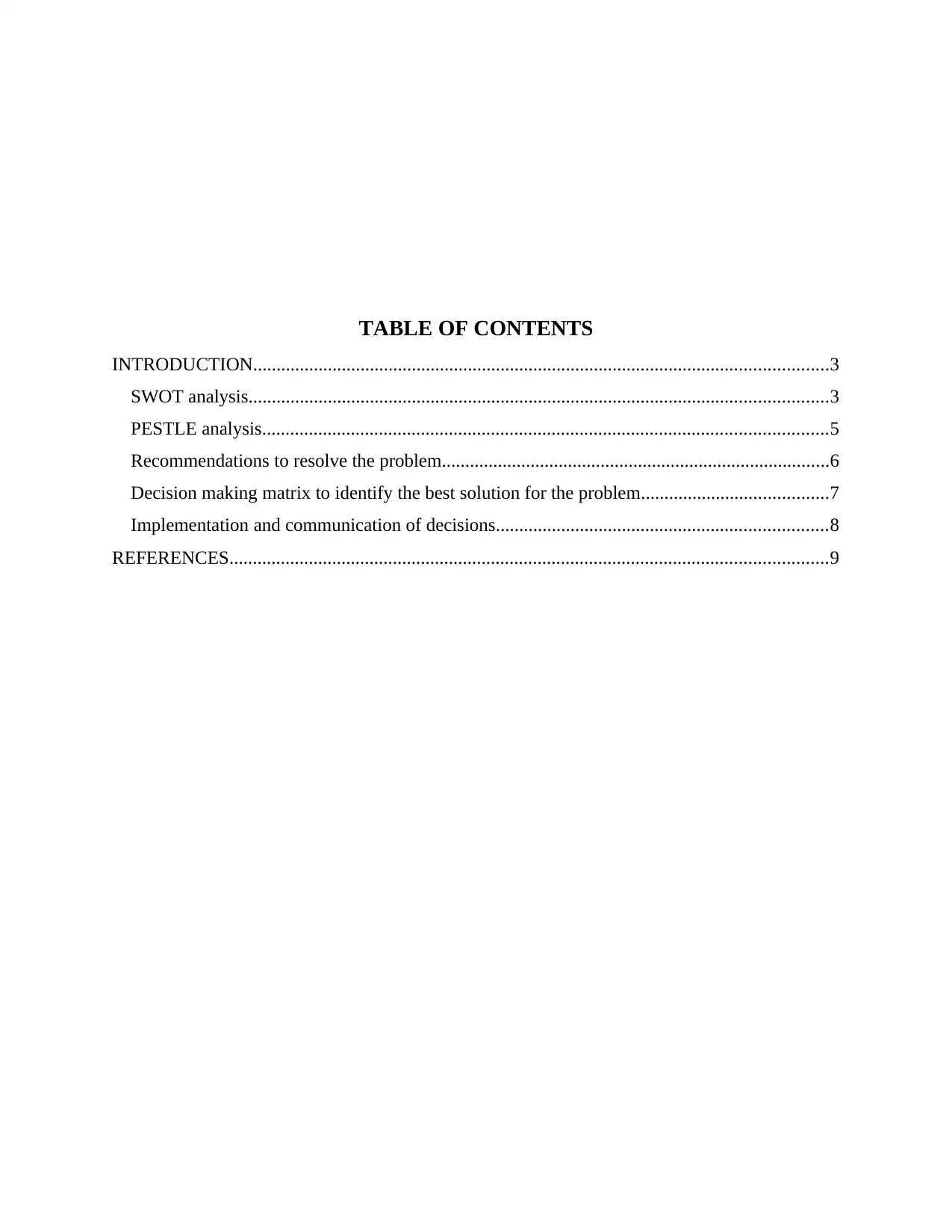
TABLE OF CONTENTS
INTRODUCTION...........................................................................................................................3
SWOT analysis............................................................................................................................3
PESTLE analysis.........................................................................................................................5
Recommendations to resolve the problem...................................................................................6
Decision making matrix to identify the best solution for the problem........................................7
Implementation and communication of decisions.......................................................................8
REFERENCES................................................................................................................................9
INTRODUCTION...........................................................................................................................3
SWOT analysis............................................................................................................................3
PESTLE analysis.........................................................................................................................5
Recommendations to resolve the problem...................................................................................6
Decision making matrix to identify the best solution for the problem........................................7
Implementation and communication of decisions.......................................................................8
REFERENCES................................................................................................................................9
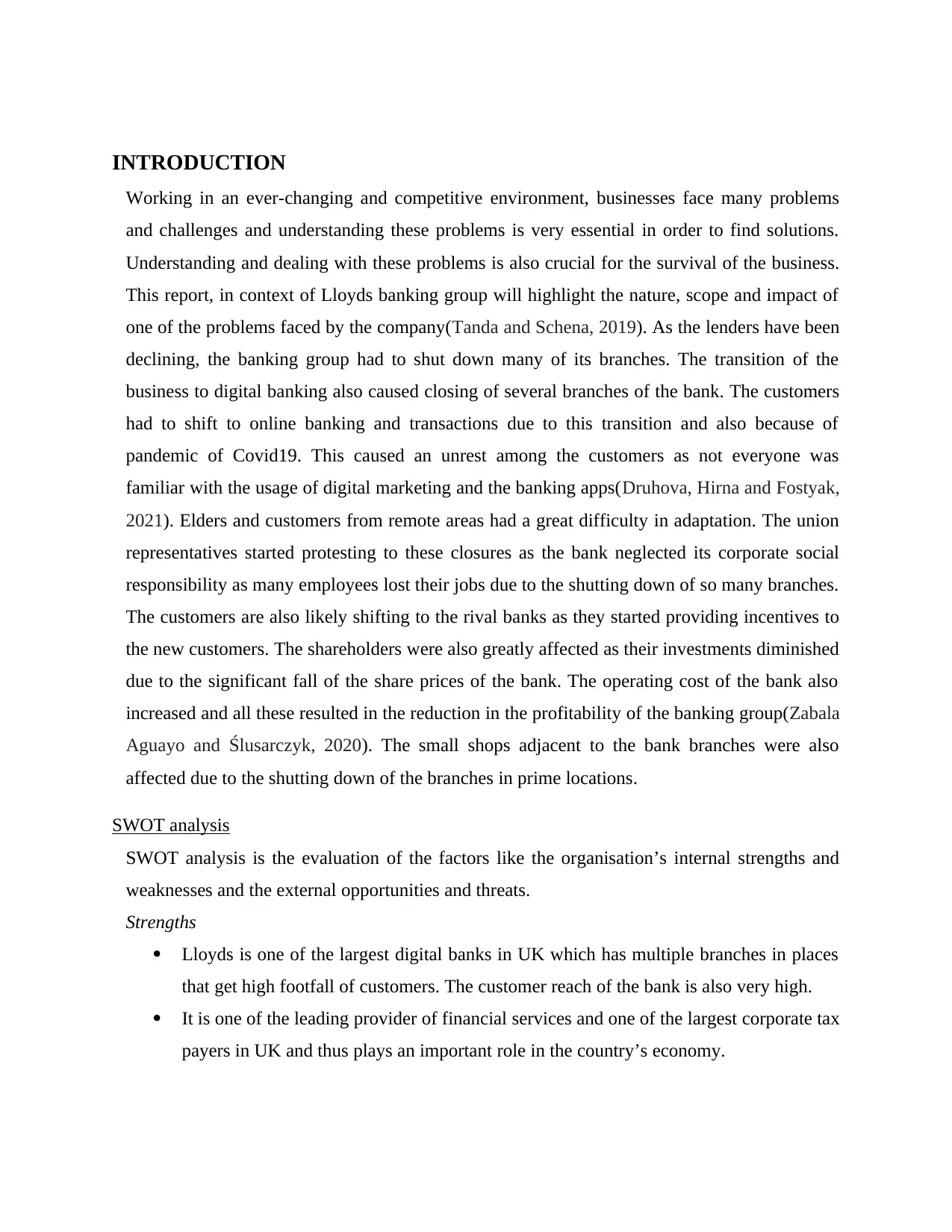
INTRODUCTION
Working in an ever-changing and competitive environment, businesses face many problems
and challenges and understanding these problems is very essential in order to find solutions.
Understanding and dealing with these problems is also crucial for the survival of the business.
This report, in context of Lloyds banking group will highlight the nature, scope and impact of
one of the problems faced by the company(Tanda and Schena, 2019). As the lenders have been
declining, the banking group had to shut down many of its branches. The transition of the
business to digital banking also caused closing of several branches of the bank. The customers
had to shift to online banking and transactions due to this transition and also because of
pandemic of Covid19. This caused an unrest among the customers as not everyone was
familiar with the usage of digital marketing and the banking apps(Druhova, Hirna and Fostyak,
2021). Elders and customers from remote areas had a great difficulty in adaptation. The union
representatives started protesting to these closures as the bank neglected its corporate social
responsibility as many employees lost their jobs due to the shutting down of so many branches.
The customers are also likely shifting to the rival banks as they started providing incentives to
the new customers. The shareholders were also greatly affected as their investments diminished
due to the significant fall of the share prices of the bank. The operating cost of the bank also
increased and all these resulted in the reduction in the profitability of the banking group(Zabala
Aguayo and Ślusarczyk, 2020). The small shops adjacent to the bank branches were also
affected due to the shutting down of the branches in prime locations.
SWOT analysis
SWOT analysis is the evaluation of the factors like the organisation’s internal strengths and
weaknesses and the external opportunities and threats.
Strengths
Lloyds is one of the largest digital banks in UK which has multiple branches in places
that get high footfall of customers. The customer reach of the bank is also very high.
It is one of the leading provider of financial services and one of the largest corporate tax
payers in UK and thus plays an important role in the country’s economy.
Working in an ever-changing and competitive environment, businesses face many problems
and challenges and understanding these problems is very essential in order to find solutions.
Understanding and dealing with these problems is also crucial for the survival of the business.
This report, in context of Lloyds banking group will highlight the nature, scope and impact of
one of the problems faced by the company(Tanda and Schena, 2019). As the lenders have been
declining, the banking group had to shut down many of its branches. The transition of the
business to digital banking also caused closing of several branches of the bank. The customers
had to shift to online banking and transactions due to this transition and also because of
pandemic of Covid19. This caused an unrest among the customers as not everyone was
familiar with the usage of digital marketing and the banking apps(Druhova, Hirna and Fostyak,
2021). Elders and customers from remote areas had a great difficulty in adaptation. The union
representatives started protesting to these closures as the bank neglected its corporate social
responsibility as many employees lost their jobs due to the shutting down of so many branches.
The customers are also likely shifting to the rival banks as they started providing incentives to
the new customers. The shareholders were also greatly affected as their investments diminished
due to the significant fall of the share prices of the bank. The operating cost of the bank also
increased and all these resulted in the reduction in the profitability of the banking group(Zabala
Aguayo and Ślusarczyk, 2020). The small shops adjacent to the bank branches were also
affected due to the shutting down of the branches in prime locations.
SWOT analysis
SWOT analysis is the evaluation of the factors like the organisation’s internal strengths and
weaknesses and the external opportunities and threats.
Strengths
Lloyds is one of the largest digital banks in UK which has multiple branches in places
that get high footfall of customers. The customer reach of the bank is also very high.
It is one of the leading provider of financial services and one of the largest corporate tax
payers in UK and thus plays an important role in the country’s economy.
⊘ This is a preview!⊘
Do you want full access?
Subscribe today to unlock all pages.

Trusted by 1+ million students worldwide
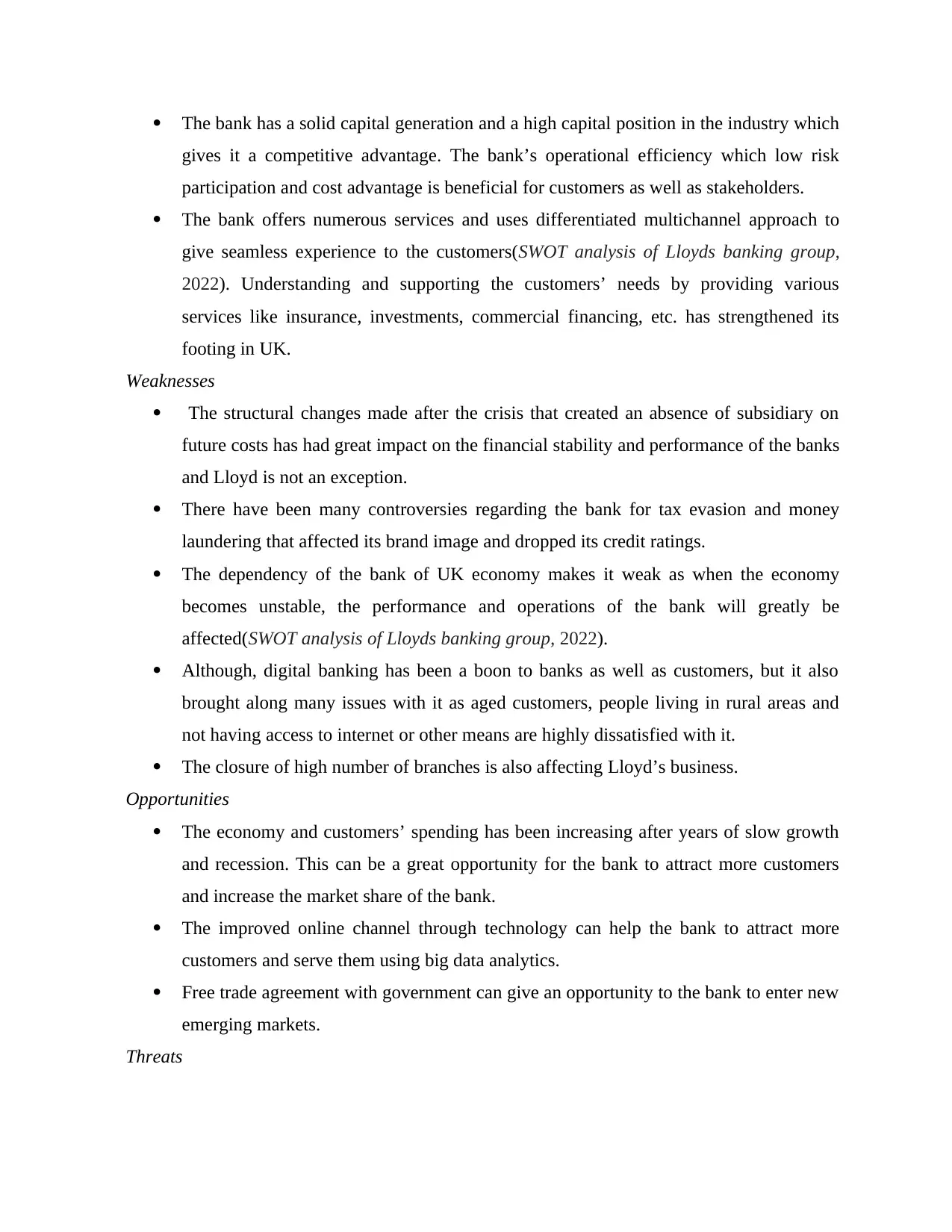
The bank has a solid capital generation and a high capital position in the industry which
gives it a competitive advantage. The bank’s operational efficiency which low risk
participation and cost advantage is beneficial for customers as well as stakeholders.
The bank offers numerous services and uses differentiated multichannel approach to
give seamless experience to the customers(SWOT analysis of Lloyds banking group,
2022). Understanding and supporting the customers’ needs by providing various
services like insurance, investments, commercial financing, etc. has strengthened its
footing in UK.
Weaknesses
The structural changes made after the crisis that created an absence of subsidiary on
future costs has had great impact on the financial stability and performance of the banks
and Lloyd is not an exception.
There have been many controversies regarding the bank for tax evasion and money
laundering that affected its brand image and dropped its credit ratings.
The dependency of the bank of UK economy makes it weak as when the economy
becomes unstable, the performance and operations of the bank will greatly be
affected(SWOT analysis of Lloyds banking group, 2022).
Although, digital banking has been a boon to banks as well as customers, but it also
brought along many issues with it as aged customers, people living in rural areas and
not having access to internet or other means are highly dissatisfied with it.
The closure of high number of branches is also affecting Lloyd’s business.
Opportunities
The economy and customers’ spending has been increasing after years of slow growth
and recession. This can be a great opportunity for the bank to attract more customers
and increase the market share of the bank.
The improved online channel through technology can help the bank to attract more
customers and serve them using big data analytics.
Free trade agreement with government can give an opportunity to the bank to enter new
emerging markets.
Threats
gives it a competitive advantage. The bank’s operational efficiency which low risk
participation and cost advantage is beneficial for customers as well as stakeholders.
The bank offers numerous services and uses differentiated multichannel approach to
give seamless experience to the customers(SWOT analysis of Lloyds banking group,
2022). Understanding and supporting the customers’ needs by providing various
services like insurance, investments, commercial financing, etc. has strengthened its
footing in UK.
Weaknesses
The structural changes made after the crisis that created an absence of subsidiary on
future costs has had great impact on the financial stability and performance of the banks
and Lloyd is not an exception.
There have been many controversies regarding the bank for tax evasion and money
laundering that affected its brand image and dropped its credit ratings.
The dependency of the bank of UK economy makes it weak as when the economy
becomes unstable, the performance and operations of the bank will greatly be
affected(SWOT analysis of Lloyds banking group, 2022).
Although, digital banking has been a boon to banks as well as customers, but it also
brought along many issues with it as aged customers, people living in rural areas and
not having access to internet or other means are highly dissatisfied with it.
The closure of high number of branches is also affecting Lloyd’s business.
Opportunities
The economy and customers’ spending has been increasing after years of slow growth
and recession. This can be a great opportunity for the bank to attract more customers
and increase the market share of the bank.
The improved online channel through technology can help the bank to attract more
customers and serve them using big data analytics.
Free trade agreement with government can give an opportunity to the bank to enter new
emerging markets.
Threats
Paraphrase This Document
Need a fresh take? Get an instant paraphrase of this document with our AI Paraphraser
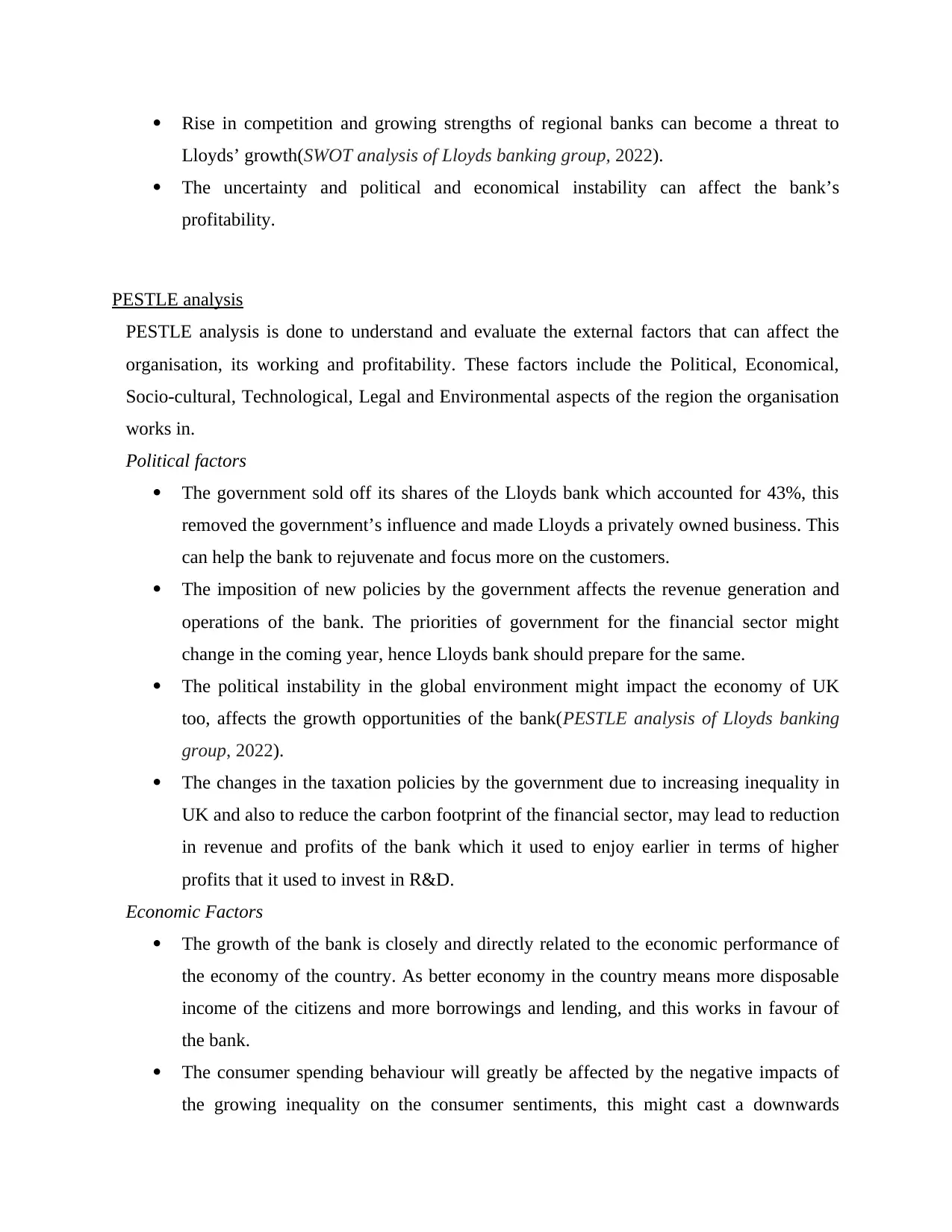
Rise in competition and growing strengths of regional banks can become a threat to
Lloyds’ growth(SWOT analysis of Lloyds banking group, 2022).
The uncertainty and political and economical instability can affect the bank’s
profitability.
PESTLE analysis
PESTLE analysis is done to understand and evaluate the external factors that can affect the
organisation, its working and profitability. These factors include the Political, Economical,
Socio-cultural, Technological, Legal and Environmental aspects of the region the organisation
works in.
Political factors
The government sold off its shares of the Lloyds bank which accounted for 43%, this
removed the government’s influence and made Lloyds a privately owned business. This
can help the bank to rejuvenate and focus more on the customers.
The imposition of new policies by the government affects the revenue generation and
operations of the bank. The priorities of government for the financial sector might
change in the coming year, hence Lloyds bank should prepare for the same.
The political instability in the global environment might impact the economy of UK
too, affects the growth opportunities of the bank(PESTLE analysis of Lloyds banking
group, 2022).
The changes in the taxation policies by the government due to increasing inequality in
UK and also to reduce the carbon footprint of the financial sector, may lead to reduction
in revenue and profits of the bank which it used to enjoy earlier in terms of higher
profits that it used to invest in R&D.
Economic Factors
The growth of the bank is closely and directly related to the economic performance of
the economy of the country. As better economy in the country means more disposable
income of the citizens and more borrowings and lending, and this works in favour of
the bank.
The consumer spending behaviour will greatly be affected by the negative impacts of
the growing inequality on the consumer sentiments, this might cast a downwards
Lloyds’ growth(SWOT analysis of Lloyds banking group, 2022).
The uncertainty and political and economical instability can affect the bank’s
profitability.
PESTLE analysis
PESTLE analysis is done to understand and evaluate the external factors that can affect the
organisation, its working and profitability. These factors include the Political, Economical,
Socio-cultural, Technological, Legal and Environmental aspects of the region the organisation
works in.
Political factors
The government sold off its shares of the Lloyds bank which accounted for 43%, this
removed the government’s influence and made Lloyds a privately owned business. This
can help the bank to rejuvenate and focus more on the customers.
The imposition of new policies by the government affects the revenue generation and
operations of the bank. The priorities of government for the financial sector might
change in the coming year, hence Lloyds bank should prepare for the same.
The political instability in the global environment might impact the economy of UK
too, affects the growth opportunities of the bank(PESTLE analysis of Lloyds banking
group, 2022).
The changes in the taxation policies by the government due to increasing inequality in
UK and also to reduce the carbon footprint of the financial sector, may lead to reduction
in revenue and profits of the bank which it used to enjoy earlier in terms of higher
profits that it used to invest in R&D.
Economic Factors
The growth of the bank is closely and directly related to the economic performance of
the economy of the country. As better economy in the country means more disposable
income of the citizens and more borrowings and lending, and this works in favour of
the bank.
The consumer spending behaviour will greatly be affected by the negative impacts of
the growing inequality on the consumer sentiments, this might cast a downwards
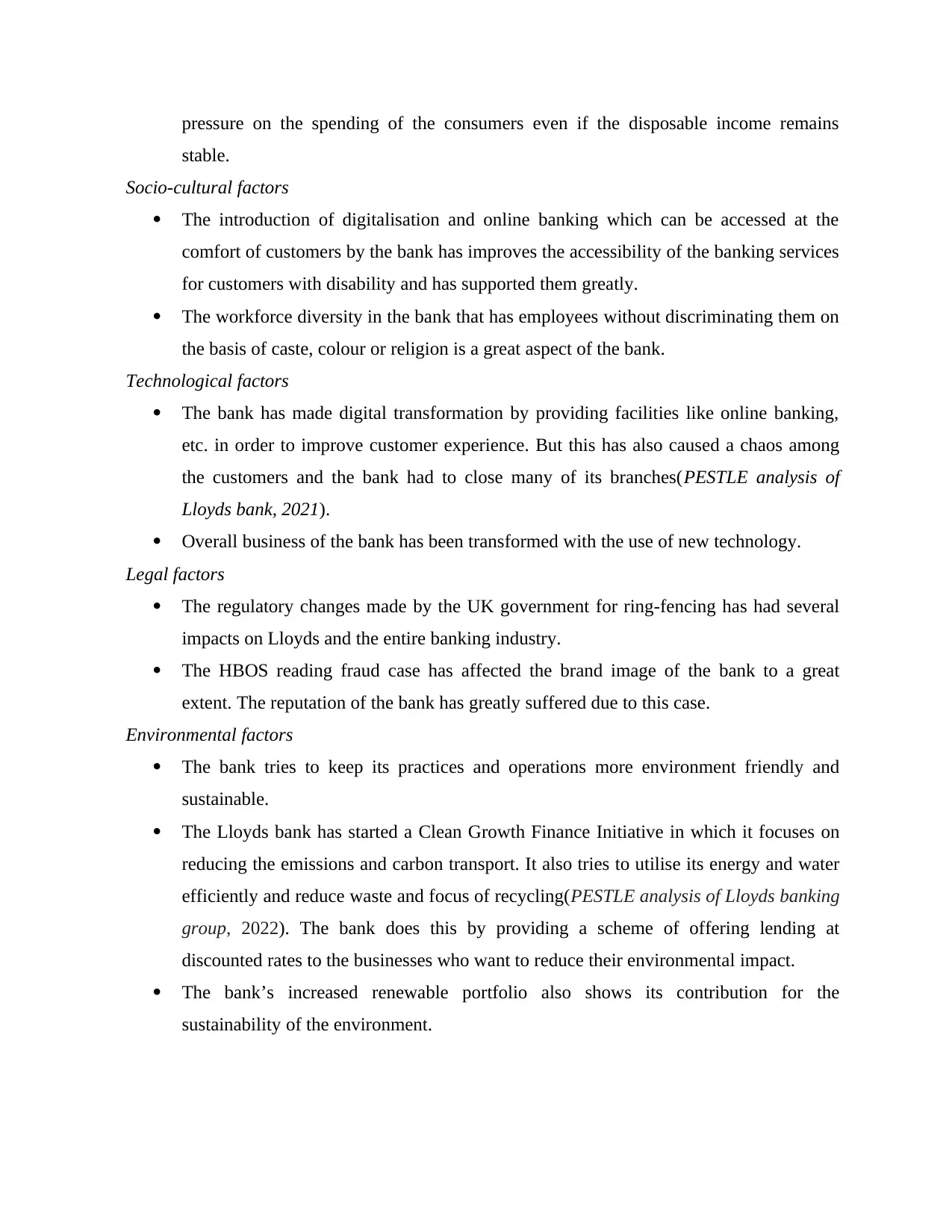
pressure on the spending of the consumers even if the disposable income remains
stable.
Socio-cultural factors
The introduction of digitalisation and online banking which can be accessed at the
comfort of customers by the bank has improves the accessibility of the banking services
for customers with disability and has supported them greatly.
The workforce diversity in the bank that has employees without discriminating them on
the basis of caste, colour or religion is a great aspect of the bank.
Technological factors
The bank has made digital transformation by providing facilities like online banking,
etc. in order to improve customer experience. But this has also caused a chaos among
the customers and the bank had to close many of its branches(PESTLE analysis of
Lloyds bank, 2021).
Overall business of the bank has been transformed with the use of new technology.
Legal factors
The regulatory changes made by the UK government for ring-fencing has had several
impacts on Lloyds and the entire banking industry.
The HBOS reading fraud case has affected the brand image of the bank to a great
extent. The reputation of the bank has greatly suffered due to this case.
Environmental factors
The bank tries to keep its practices and operations more environment friendly and
sustainable.
The Lloyds bank has started a Clean Growth Finance Initiative in which it focuses on
reducing the emissions and carbon transport. It also tries to utilise its energy and water
efficiently and reduce waste and focus of recycling(PESTLE analysis of Lloyds banking
group, 2022). The bank does this by providing a scheme of offering lending at
discounted rates to the businesses who want to reduce their environmental impact.
The bank’s increased renewable portfolio also shows its contribution for the
sustainability of the environment.
stable.
Socio-cultural factors
The introduction of digitalisation and online banking which can be accessed at the
comfort of customers by the bank has improves the accessibility of the banking services
for customers with disability and has supported them greatly.
The workforce diversity in the bank that has employees without discriminating them on
the basis of caste, colour or religion is a great aspect of the bank.
Technological factors
The bank has made digital transformation by providing facilities like online banking,
etc. in order to improve customer experience. But this has also caused a chaos among
the customers and the bank had to close many of its branches(PESTLE analysis of
Lloyds bank, 2021).
Overall business of the bank has been transformed with the use of new technology.
Legal factors
The regulatory changes made by the UK government for ring-fencing has had several
impacts on Lloyds and the entire banking industry.
The HBOS reading fraud case has affected the brand image of the bank to a great
extent. The reputation of the bank has greatly suffered due to this case.
Environmental factors
The bank tries to keep its practices and operations more environment friendly and
sustainable.
The Lloyds bank has started a Clean Growth Finance Initiative in which it focuses on
reducing the emissions and carbon transport. It also tries to utilise its energy and water
efficiently and reduce waste and focus of recycling(PESTLE analysis of Lloyds banking
group, 2022). The bank does this by providing a scheme of offering lending at
discounted rates to the businesses who want to reduce their environmental impact.
The bank’s increased renewable portfolio also shows its contribution for the
sustainability of the environment.
⊘ This is a preview!⊘
Do you want full access?
Subscribe today to unlock all pages.

Trusted by 1+ million students worldwide
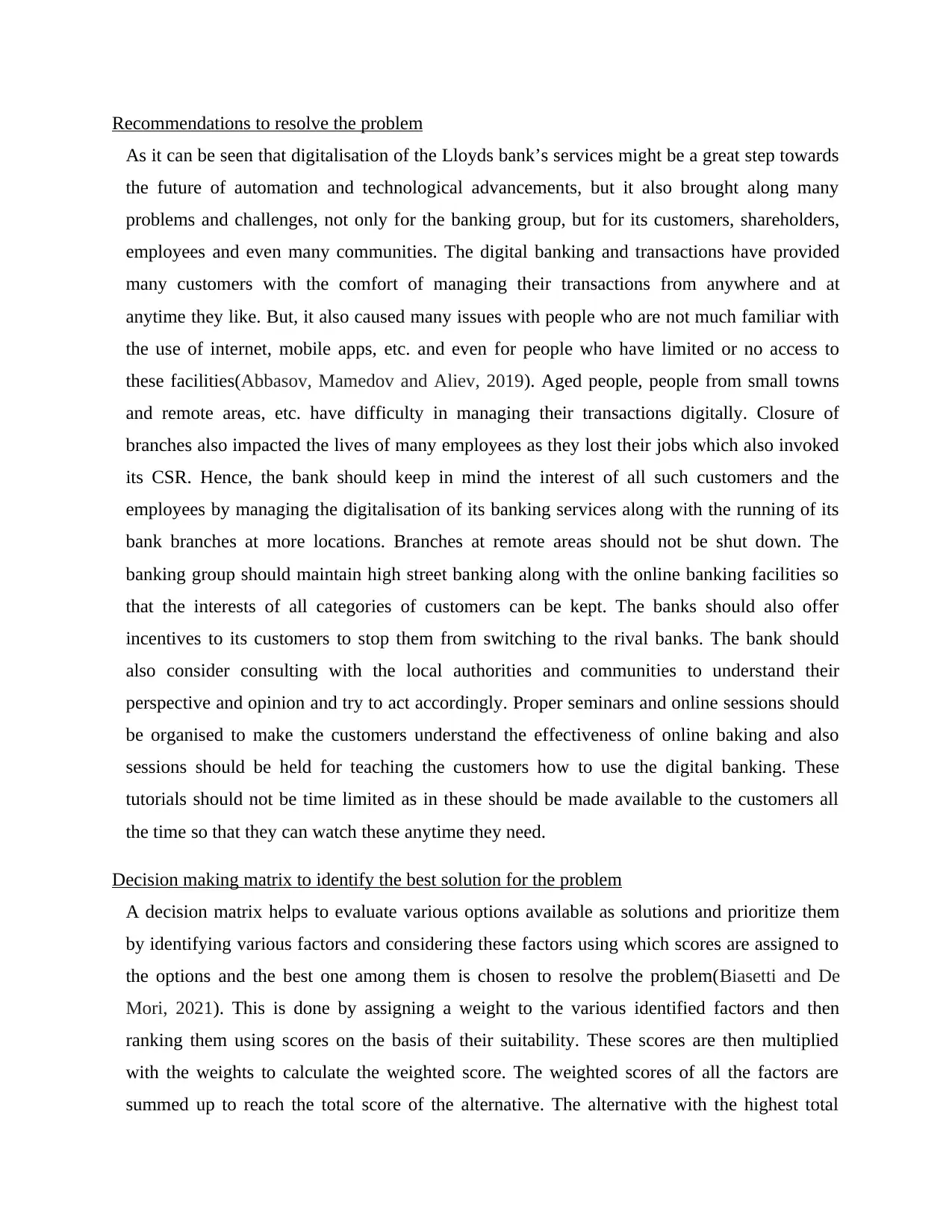
Recommendations to resolve the problem
As it can be seen that digitalisation of the Lloyds bank’s services might be a great step towards
the future of automation and technological advancements, but it also brought along many
problems and challenges, not only for the banking group, but for its customers, shareholders,
employees and even many communities. The digital banking and transactions have provided
many customers with the comfort of managing their transactions from anywhere and at
anytime they like. But, it also caused many issues with people who are not much familiar with
the use of internet, mobile apps, etc. and even for people who have limited or no access to
these facilities(Abbasov, Mamedov and Aliev, 2019). Aged people, people from small towns
and remote areas, etc. have difficulty in managing their transactions digitally. Closure of
branches also impacted the lives of many employees as they lost their jobs which also invoked
its CSR. Hence, the bank should keep in mind the interest of all such customers and the
employees by managing the digitalisation of its banking services along with the running of its
bank branches at more locations. Branches at remote areas should not be shut down. The
banking group should maintain high street banking along with the online banking facilities so
that the interests of all categories of customers can be kept. The banks should also offer
incentives to its customers to stop them from switching to the rival banks. The bank should
also consider consulting with the local authorities and communities to understand their
perspective and opinion and try to act accordingly. Proper seminars and online sessions should
be organised to make the customers understand the effectiveness of online baking and also
sessions should be held for teaching the customers how to use the digital banking. These
tutorials should not be time limited as in these should be made available to the customers all
the time so that they can watch these anytime they need.
Decision making matrix to identify the best solution for the problem
A decision matrix helps to evaluate various options available as solutions and prioritize them
by identifying various factors and considering these factors using which scores are assigned to
the options and the best one among them is chosen to resolve the problem(Biasetti and De
Mori, 2021). This is done by assigning a weight to the various identified factors and then
ranking them using scores on the basis of their suitability. These scores are then multiplied
with the weights to calculate the weighted score. The weighted scores of all the factors are
summed up to reach the total score of the alternative. The alternative with the highest total
As it can be seen that digitalisation of the Lloyds bank’s services might be a great step towards
the future of automation and technological advancements, but it also brought along many
problems and challenges, not only for the banking group, but for its customers, shareholders,
employees and even many communities. The digital banking and transactions have provided
many customers with the comfort of managing their transactions from anywhere and at
anytime they like. But, it also caused many issues with people who are not much familiar with
the use of internet, mobile apps, etc. and even for people who have limited or no access to
these facilities(Abbasov, Mamedov and Aliev, 2019). Aged people, people from small towns
and remote areas, etc. have difficulty in managing their transactions digitally. Closure of
branches also impacted the lives of many employees as they lost their jobs which also invoked
its CSR. Hence, the bank should keep in mind the interest of all such customers and the
employees by managing the digitalisation of its banking services along with the running of its
bank branches at more locations. Branches at remote areas should not be shut down. The
banking group should maintain high street banking along with the online banking facilities so
that the interests of all categories of customers can be kept. The banks should also offer
incentives to its customers to stop them from switching to the rival banks. The bank should
also consider consulting with the local authorities and communities to understand their
perspective and opinion and try to act accordingly. Proper seminars and online sessions should
be organised to make the customers understand the effectiveness of online baking and also
sessions should be held for teaching the customers how to use the digital banking. These
tutorials should not be time limited as in these should be made available to the customers all
the time so that they can watch these anytime they need.
Decision making matrix to identify the best solution for the problem
A decision matrix helps to evaluate various options available as solutions and prioritize them
by identifying various factors and considering these factors using which scores are assigned to
the options and the best one among them is chosen to resolve the problem(Biasetti and De
Mori, 2021). This is done by assigning a weight to the various identified factors and then
ranking them using scores on the basis of their suitability. These scores are then multiplied
with the weights to calculate the weighted score. The weighted scores of all the factors are
summed up to reach the total score of the alternative. The alternative with the highest total
Paraphrase This Document
Need a fresh take? Get an instant paraphrase of this document with our AI Paraphraser
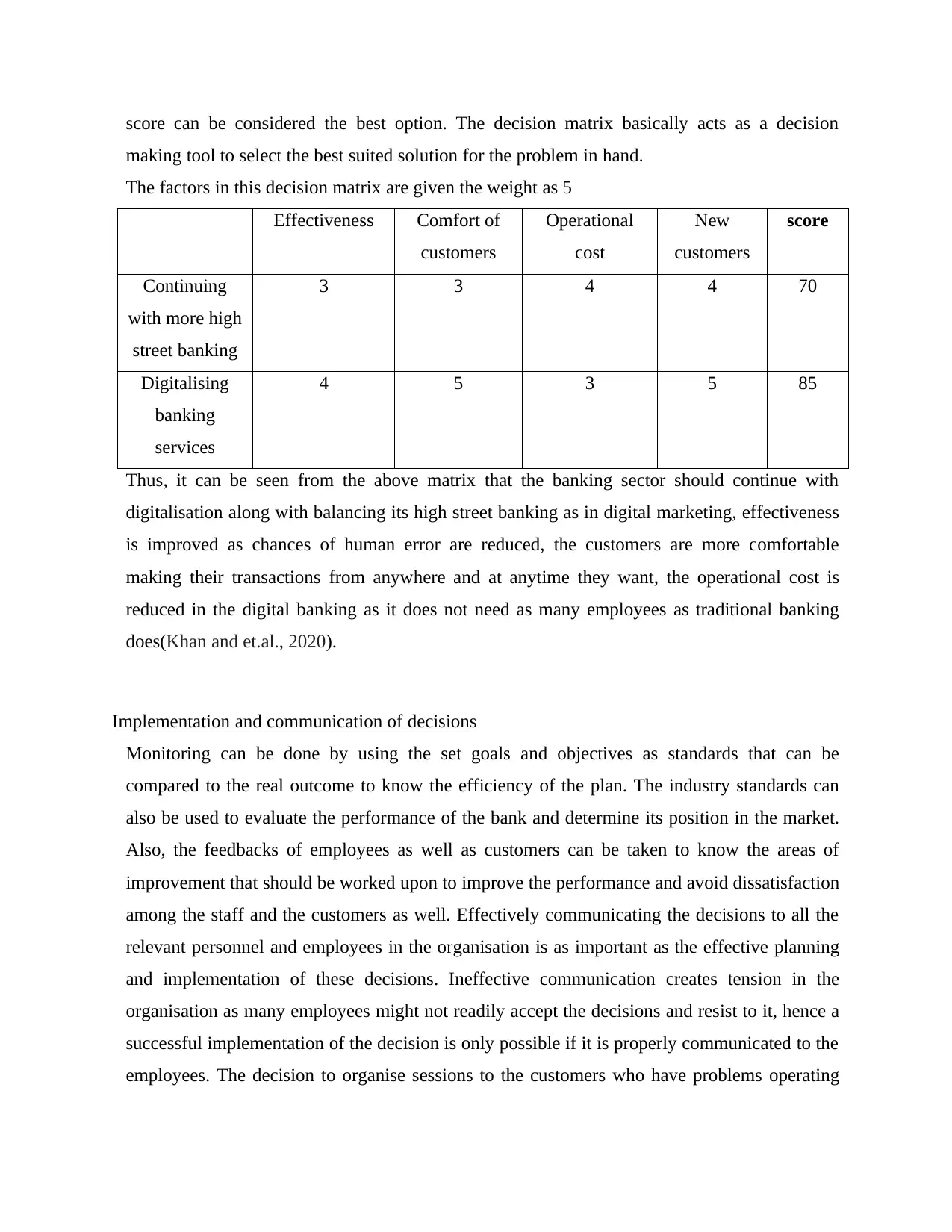
score can be considered the best option. The decision matrix basically acts as a decision
making tool to select the best suited solution for the problem in hand.
The factors in this decision matrix are given the weight as 5
Effectiveness Comfort of
customers
Operational
cost
New
customers
score
Continuing
with more high
street banking
3 3 4 4 70
Digitalising
banking
services
4 5 3 5 85
Thus, it can be seen from the above matrix that the banking sector should continue with
digitalisation along with balancing its high street banking as in digital marketing, effectiveness
is improved as chances of human error are reduced, the customers are more comfortable
making their transactions from anywhere and at anytime they want, the operational cost is
reduced in the digital banking as it does not need as many employees as traditional banking
does(Khan and et.al., 2020).
Implementation and communication of decisions
Monitoring can be done by using the set goals and objectives as standards that can be
compared to the real outcome to know the efficiency of the plan. The industry standards can
also be used to evaluate the performance of the bank and determine its position in the market.
Also, the feedbacks of employees as well as customers can be taken to know the areas of
improvement that should be worked upon to improve the performance and avoid dissatisfaction
among the staff and the customers as well. Effectively communicating the decisions to all the
relevant personnel and employees in the organisation is as important as the effective planning
and implementation of these decisions. Ineffective communication creates tension in the
organisation as many employees might not readily accept the decisions and resist to it, hence a
successful implementation of the decision is only possible if it is properly communicated to the
employees. The decision to organise sessions to the customers who have problems operating
making tool to select the best suited solution for the problem in hand.
The factors in this decision matrix are given the weight as 5
Effectiveness Comfort of
customers
Operational
cost
New
customers
score
Continuing
with more high
street banking
3 3 4 4 70
Digitalising
banking
services
4 5 3 5 85
Thus, it can be seen from the above matrix that the banking sector should continue with
digitalisation along with balancing its high street banking as in digital marketing, effectiveness
is improved as chances of human error are reduced, the customers are more comfortable
making their transactions from anywhere and at anytime they want, the operational cost is
reduced in the digital banking as it does not need as many employees as traditional banking
does(Khan and et.al., 2020).
Implementation and communication of decisions
Monitoring can be done by using the set goals and objectives as standards that can be
compared to the real outcome to know the efficiency of the plan. The industry standards can
also be used to evaluate the performance of the bank and determine its position in the market.
Also, the feedbacks of employees as well as customers can be taken to know the areas of
improvement that should be worked upon to improve the performance and avoid dissatisfaction
among the staff and the customers as well. Effectively communicating the decisions to all the
relevant personnel and employees in the organisation is as important as the effective planning
and implementation of these decisions. Ineffective communication creates tension in the
organisation as many employees might not readily accept the decisions and resist to it, hence a
successful implementation of the decision is only possible if it is properly communicated to the
employees. The decision to organise sessions to the customers who have problems operating

the digital banking and recording various videos that could be used by these customers
whenever needed should be communicated to the employees.
whenever needed should be communicated to the employees.
⊘ This is a preview!⊘
Do you want full access?
Subscribe today to unlock all pages.

Trusted by 1+ million students worldwide
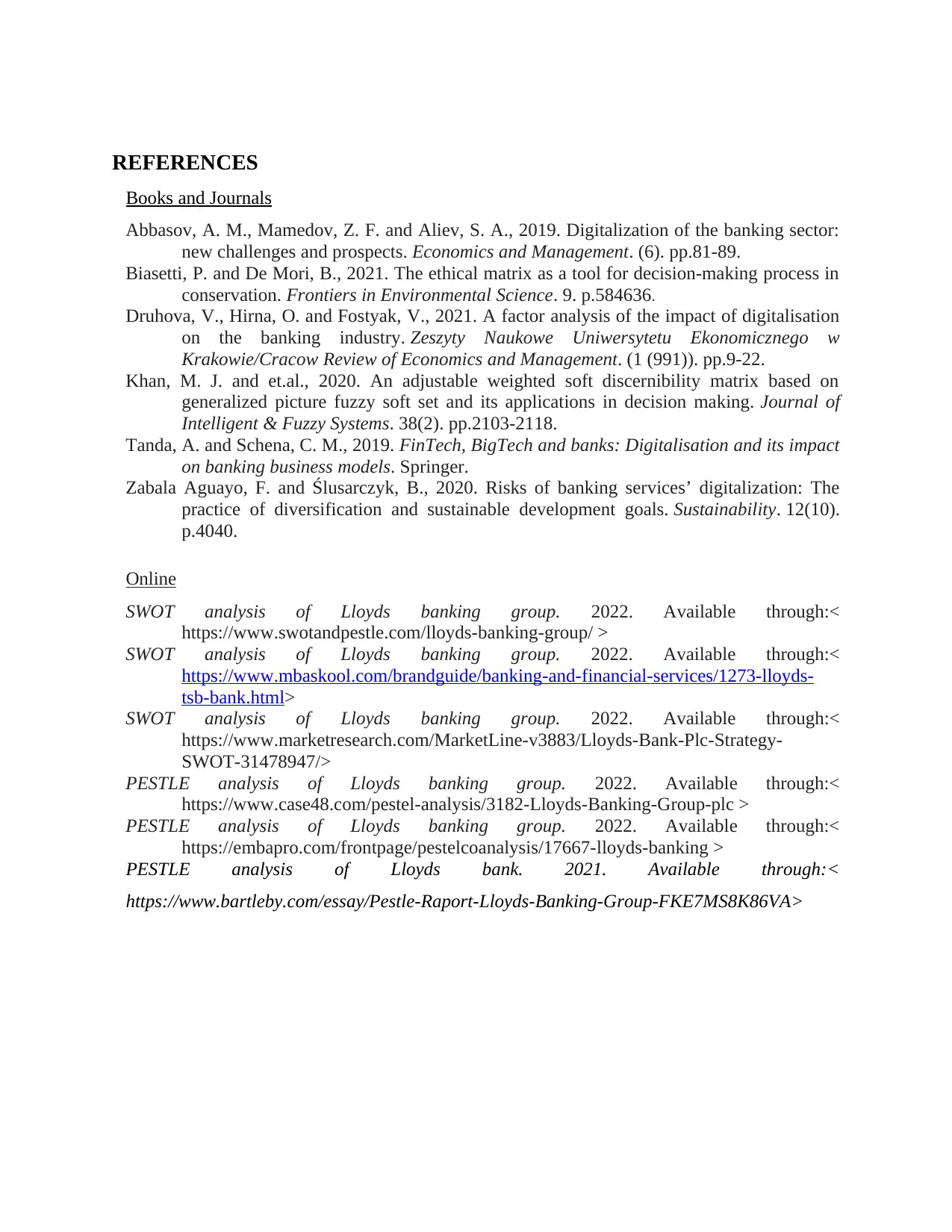
REFERENCES
Books and Journals
Abbasov, A. M., Mamedov, Z. F. and Aliev, S. A., 2019. Digitalization of the banking sector:
new challenges and prospects. Economics and Management. (6). pp.81-89.
Biasetti, P. and De Mori, B., 2021. The ethical matrix as a tool for decision-making process in
conservation. Frontiers in Environmental Science. 9. p.584636.
Druhova, V., Hirna, O. and Fostyak, V., 2021. A factor analysis of the impact of digitalisation
on the banking industry. Zeszyty Naukowe Uniwersytetu Ekonomicznego w
Krakowie/Cracow Review of Economics and Management. (1 (991)). pp.9-22.
Khan, M. J. and et.al., 2020. An adjustable weighted soft discernibility matrix based on
generalized picture fuzzy soft set and its applications in decision making. Journal of
Intelligent & Fuzzy Systems. 38(2). pp.2103-2118.
Tanda, A. and Schena, C. M., 2019. FinTech, BigTech and banks: Digitalisation and its impact
on banking business models. Springer.
Zabala Aguayo, F. and Ślusarczyk, B., 2020. Risks of banking services’ digitalization: The
practice of diversification and sustainable development goals. Sustainability. 12(10).
p.4040.
Online
SWOT analysis of Lloyds banking group. 2022. Available through:<
https://www.swotandpestle.com/lloyds-banking-group/ >
SWOT analysis of Lloyds banking group. 2022. Available through:<
https://www.mbaskool.com/brandguide/banking-and-financial-services/1273-lloyds-
tsb-bank.html>
SWOT analysis of Lloyds banking group. 2022. Available through:<
https://www.marketresearch.com/MarketLine-v3883/Lloyds-Bank-Plc-Strategy-
SWOT-31478947/>
PESTLE analysis of Lloyds banking group. 2022. Available through:<
https://www.case48.com/pestel-analysis/3182-Lloyds-Banking-Group-plc >
PESTLE analysis of Lloyds banking group. 2022. Available through:<
https://embapro.com/frontpage/pestelcoanalysis/17667-lloyds-banking >
PESTLE analysis of Lloyds bank. 2021. Available through:<
https://www.bartleby.com/essay/Pestle-Raport-Lloyds-Banking-Group-FKE7MS8K86VA>
Books and Journals
Abbasov, A. M., Mamedov, Z. F. and Aliev, S. A., 2019. Digitalization of the banking sector:
new challenges and prospects. Economics and Management. (6). pp.81-89.
Biasetti, P. and De Mori, B., 2021. The ethical matrix as a tool for decision-making process in
conservation. Frontiers in Environmental Science. 9. p.584636.
Druhova, V., Hirna, O. and Fostyak, V., 2021. A factor analysis of the impact of digitalisation
on the banking industry. Zeszyty Naukowe Uniwersytetu Ekonomicznego w
Krakowie/Cracow Review of Economics and Management. (1 (991)). pp.9-22.
Khan, M. J. and et.al., 2020. An adjustable weighted soft discernibility matrix based on
generalized picture fuzzy soft set and its applications in decision making. Journal of
Intelligent & Fuzzy Systems. 38(2). pp.2103-2118.
Tanda, A. and Schena, C. M., 2019. FinTech, BigTech and banks: Digitalisation and its impact
on banking business models. Springer.
Zabala Aguayo, F. and Ślusarczyk, B., 2020. Risks of banking services’ digitalization: The
practice of diversification and sustainable development goals. Sustainability. 12(10).
p.4040.
Online
SWOT analysis of Lloyds banking group. 2022. Available through:<
https://www.swotandpestle.com/lloyds-banking-group/ >
SWOT analysis of Lloyds banking group. 2022. Available through:<
https://www.mbaskool.com/brandguide/banking-and-financial-services/1273-lloyds-
tsb-bank.html>
SWOT analysis of Lloyds banking group. 2022. Available through:<
https://www.marketresearch.com/MarketLine-v3883/Lloyds-Bank-Plc-Strategy-
SWOT-31478947/>
PESTLE analysis of Lloyds banking group. 2022. Available through:<
https://www.case48.com/pestel-analysis/3182-Lloyds-Banking-Group-plc >
PESTLE analysis of Lloyds banking group. 2022. Available through:<
https://embapro.com/frontpage/pestelcoanalysis/17667-lloyds-banking >
PESTLE analysis of Lloyds bank. 2021. Available through:<
https://www.bartleby.com/essay/Pestle-Raport-Lloyds-Banking-Group-FKE7MS8K86VA>
1 out of 10
Related Documents
Your All-in-One AI-Powered Toolkit for Academic Success.
+13062052269
info@desklib.com
Available 24*7 on WhatsApp / Email
![[object Object]](/_next/static/media/star-bottom.7253800d.svg)
Unlock your academic potential
Copyright © 2020–2025 A2Z Services. All Rights Reserved. Developed and managed by ZUCOL.





